PASELEC GS9 Review 2024
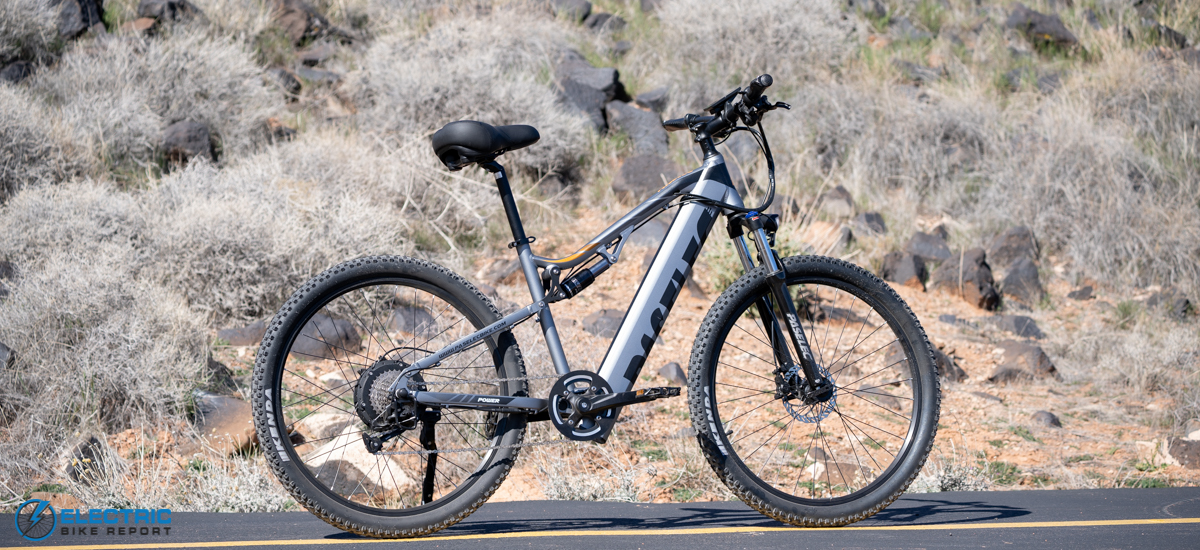
From the moment we received the PASELEC GS9 for review I knew what the hook for prospective buyers would be: It’s a full suspension e-bike with mountain bike styling for well under $2K.
While that may be the hook, the rest of the spec sheet seemed to offer plenty worth sticking around for: A 500W motor capable of class 3 speeds, 624 Wh battery and Zoom hydraulic disc brakes with 180mm rotors.
But could a fully-loaded e-bike on everybody’s favorite end of the affordability spectrum deliver the goods? That’s the question we set out to answer.
But first, expectations need to be set accordingly. That much bike on that little of a budget won’t be without compromise, but compromise doesn’t have to be a bad thing necessarily. And having your expectations set to the proper level can make all the difference in determining whether or not you’ll be happy with it in the end.
In this review of the PASELEC GS9 we put the bike through its paces via a series of tests designed to better understand its motor, braking, handling capabilities and so much more. Keep reading down below for greater insight on what the bike is all about.
***The GS9’s speed settings applied to both the throttle and PAS on the bike we tested. This doesn’t follow the 3 class legal framework that is the most widely accepted. Consult your local laws to know the proper way to configure your speed settings.
 Pro’s
Pro’s- The 500W motor punches above its weight class – it recorded one of my fastest circuit laps ever.
- Styling will always be subjective, but it is a good looking bike in this reviewer’s eyes.
- Coming equipped with hydraulic disc brakes at this price point is a great value.
- The bike rolls efficiently which leads to great battery life, especially at lower PAS.
- The removable battery doesn’t compromise the downtube due to its unique design, but…
 Con’s
Con’s- …removing the battery out of the bottom of the down tube is a little more cumbersome than most designs.
- The cadence sensor takes several cranks on the pedals to get the motor to engage – more than most other cadence sensor setups we’ve tested.
- The suspension system works okay, but it’s definitely on the budget-end of the spectrum so anticipate having to swap it out one day.
- Battery: 48V, 13Ah (624Wh) Panasonic Battery
- Display: Color LCD Display
- Motor: 500W hub motor
- Headlight: Included
- Taillights: None
- Peal Assist: 1-5, cadence sensor
- Range: 25-50 miles
- Throttle: Thumb lever
- Claimed weight: 59.5 lbs
- Maximum rider weight: 220 lbs
- Brakes: Zoom hydraulic disc brakes with 180 mm rotors
- Fenders: None
- Fork: 100 mm travel
- Rear suspension: HLT-100 SHOCK, 40 mm four-link suspension
- Frame: 6061 aluminum
- Drivetrain: L-Twoo A5 9-speed
- Grips: Ergonomic faux leather grips
- Saddle: Breathable material
- Kickstand: Included
- Tires: 27.5” KENDA OR CST Mountain Tires
PASELEC GS9 Review: Bike Overview
PASELEC is based out of Hong Kong, and, according to how they’ve labeled bikes on their website, the brand focuses on models geared towards the off-roading crowd.
PASELEC calls the GS9 an electric mountain bike, but I’d classify it further as a light-duty trail bike, or even a bike best suited for paved trail riders wanting some cooler-looking mountain bike aesthetics. I’ve known several people who fit that shopper profile and I think the PASELEC GS9 could be a great way to satisfy that search on the cheap.
Just to set the expectation accordingly, this isn’t the type of bike I’d look to take on some of our renowned local mountain bike trails in southern Utah for reasons we’ll explore in greater detail in the handling section.
It isn’t a downhill bomber, and I don’t know that it needs to be. It’s a budget-level e-bike for a reason, and having the proper perspective of what it is will be the key to discovering what it does well vs. what it doesn’t do well.
Undoubtedly one of the draws for many people looking into this bike will be its full-suspension setup. I can tell you that the four-link 40mm rear suspension in use on this bike performs okay, but it is definitely on the budget end of the spectrum, which makes it better suited for those lighter trails or smoothing out bumps while commuting as opposed to hitting any huge jumps.
The GS9 has some highlight features for the speed-hungry crowd. The 500W motor can absolutely hit the 28 mph class 3 speed limits, and it accelerates like it’s running late for work. Another factor helping you hit those speeds is a set of 27.5” X 2.2” Kenda tires, though PASELEC says it may come with a similar CST set. It has a chunkier tread, but it rolls efficiently which is good for coasting on the road.
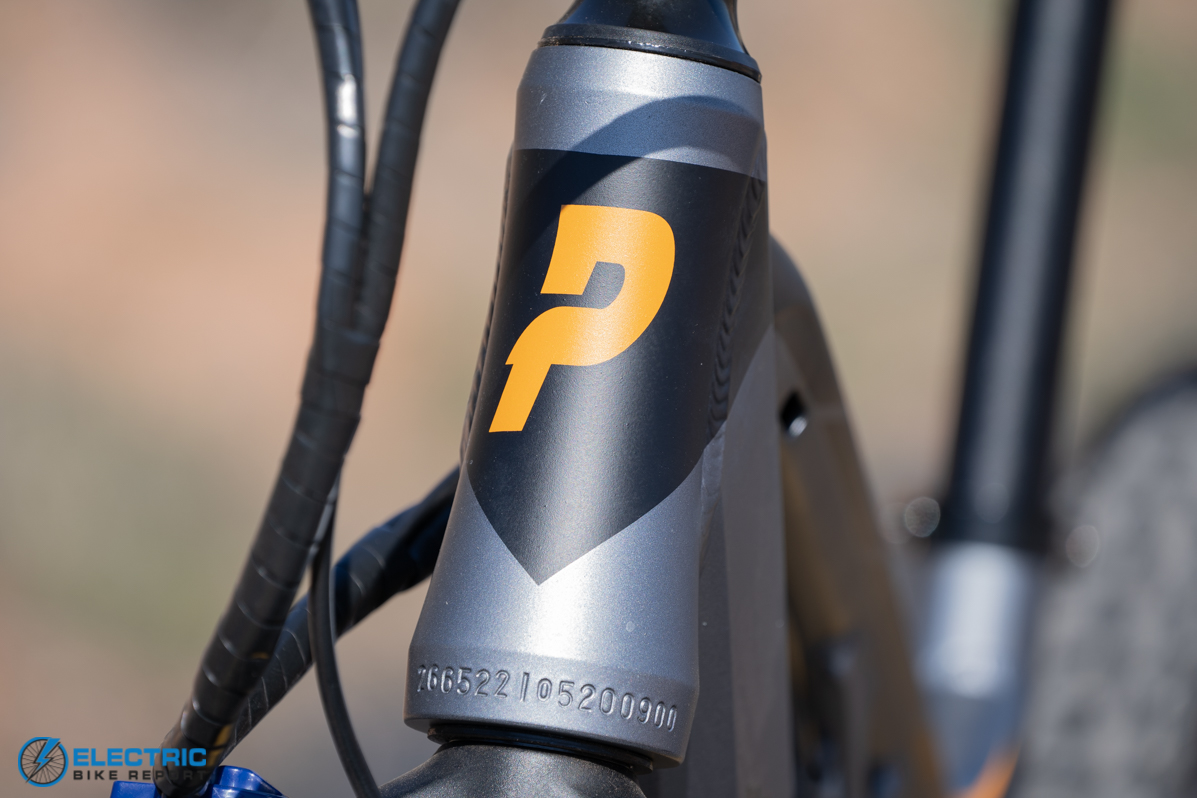
PASELEC derives its name from the assistance e-bikes are known for giving.
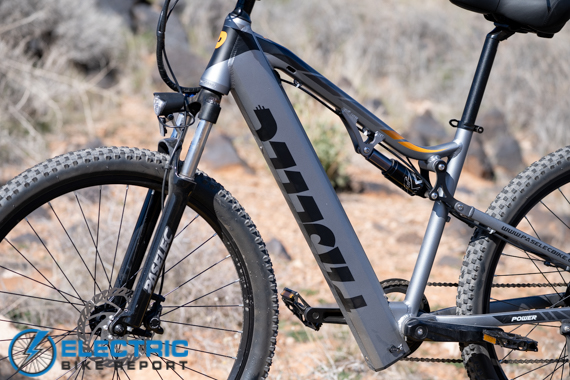
The full-suspension setup of the GS9 is uncommonly found in the $1,500 ballpark.

The front fork gives 100mm of travel for smoothing out trails.
PASELEC GS9 Review: Motor Performance, Speed and Acceleration
Most people assume you’ll need a 750W motor to really get up to the 28 mph limit of Class 3 speeds. In the case of the GS9, most people would be wrong.
The 500W rear hub motor of the PASELEC GS9 is flat-out fast. While the bike was no doubt aided by some surprisingly well-rolling Kenda mountain bike tires, there’s simply no denying that the GS9 is one of the fastest bikes I’ve ever tested.
The PAS 5 lap I recorded was the second fastest I’ve ever had. The only one to beat it? The 1000W QuietKat Jeep we reviewed a few weeks ago. Talk about the little engine (motor) that could.
Now every e-bike we review is a team effort, but the test I most frequently cover is the circuit test. I’ve tested a little over half of all the e-bikes since we added the circuit test to our standardized review process, so holding the second place hot lap title is saying something.
People will perceive that kind of speed differently. Some might love it, while others might want to proceed with caution. I will say that the suspension of the bike is a little on the bouncy side, so make sure you’re comfortable with the overall handling before letting it rip.
One drawback to the motor is the fact that it took several rotations of the pedals to get the PAS to engage. Cadence sensor PAS setups aren’t as responsive as torque sensor options, but even when stacking it up to other cadence sensors I’ve tried in the past it took noticeably more rotations of the cranks to get the bike to go. It made starting out from dead-stops with the throttle my go-to while riding around on the GS9.
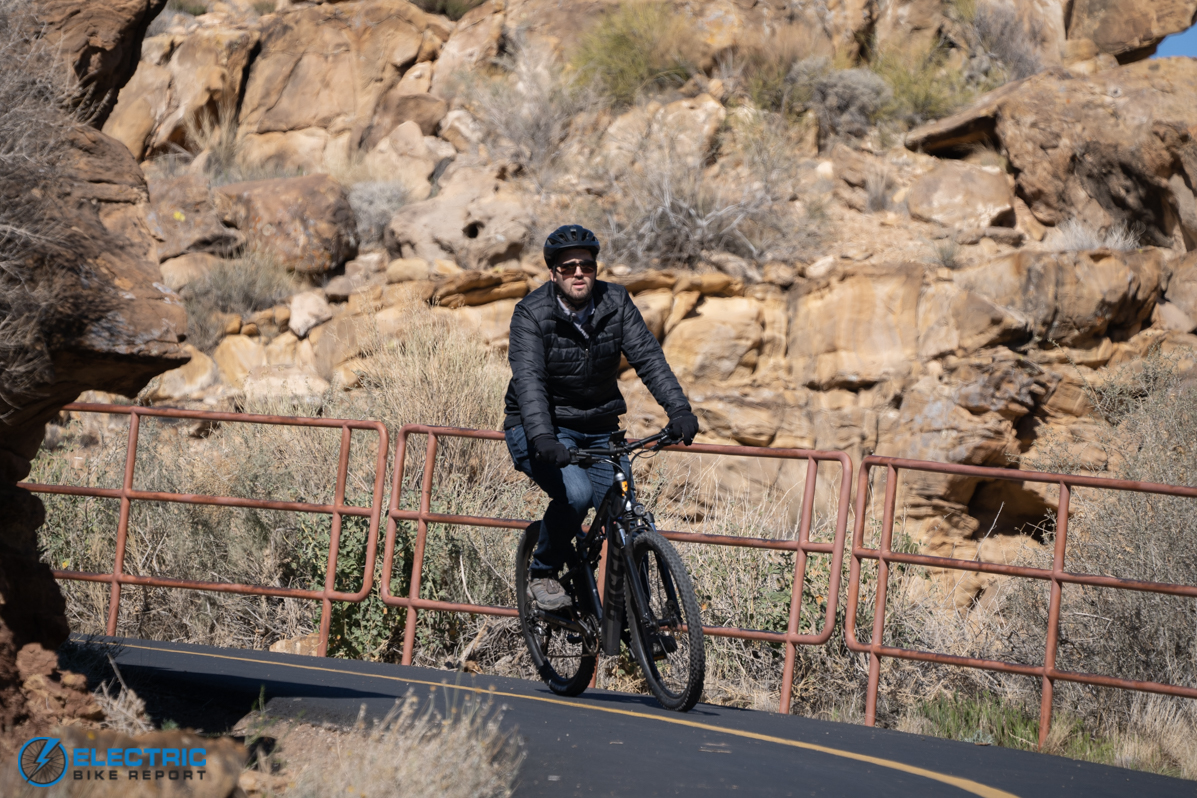
The PASELEC GS9 is quick-moving and efficient.
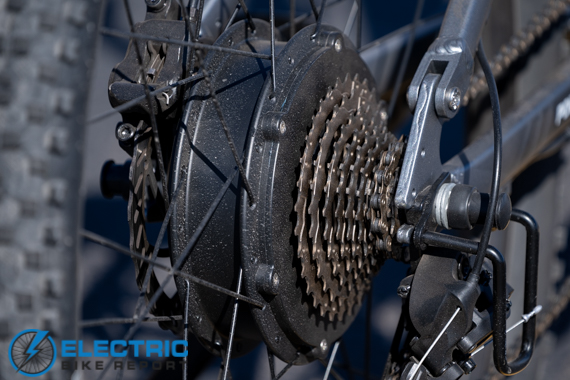
The rear hub motor is quite fast for being “only” 500W.
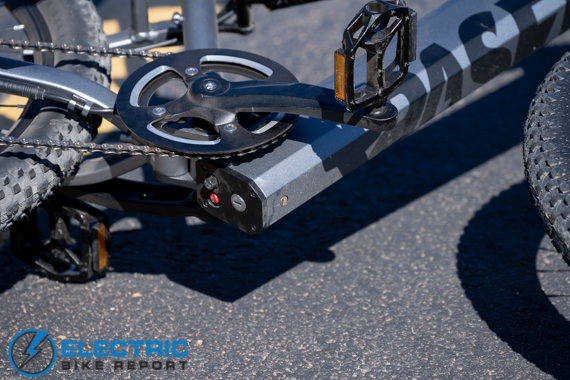
The PASELEC GS9 has a removable battery you slide out of the bottom of the frame – something we don’t see often.
PASELEC GS9 Review: Range Test & Battery Performance
Powering the PASELEC GS9 is a 48V, 13Ah (624Wh) Panasonic battery. A decent battery size given the 500W motor on the bike.
The battery is integrated into the bike’s frame. Interestingly enough, you can remove the battery (which we’re used to seeing) by sliding it out of the bottom end of the downtube (which we’re not used to seeing).
Having a removable battery will always remain a plus in our eyes on any e-bike we review, but this is one of the stranger setups we’ve seen for removing the battery. Typically you can pull a battery straight out of the frame, or by sliding off an external battery pack. But given the design of the GS9, the battery can only be removed if you lay down the bike and then slide it out (or by suspending the bike very, very high in the air). It’s a bit of a strange setup that isn’t a deal-breaker, but it’s definitely odd compared to the norm.
Odd setup choices aside, the battery performs quite well on the GS9 as evidenced by the results of our graph above. Twenty five miles on the high PAS end and 48 miles on the low PAS end is an impressive result — even more so when you consider that the team for this battery review was two of the bigger and taller EBR test riders.
No matter your intended use for the bike, be it on the dirt trails, paths or roads, the GS9 should give you plenty of battery to ride around with.
PASELEC GS9 Review: Hill Test
While I’ve touched on the speed of the motor, that’s only one important benefit of having motor-equipped bikes. Arguably the bigger draw is how it helps on hills.
The 500W rear hub motor on the PASELEC GS9 holds up well in pedal assist. While conducting our hill test, I didn’t even hear the motor very much as it was just plugging away (I did hear plenty of squeak from the rear shock though). It gave me steady assistance and didn’t add much vibration to the ride. It didn’t match any record times for me personally up the hill as it did on the circuit test, but finishing the test is an accomplishment in itself.
To further validate my previous statement, the throttle test failed to deliver me to the top of the hill, and it stopped well short of summiting the first pitch despite the running start I gave it. This isn’t to point out that I think it’s a bad motor on a bad bike, but it does illustrate why I think the bike is better served for light-duty trail riding as opposed to full-boar eMTB riding. It’s a motor that’s quicker on flatter riding areas and will help you out okay on hills but it won’t be doing all the work for you.

The PASELEC GS9 maneuvers well on paved trails.

The L-Twoo A5 9-speed rear derailleur.
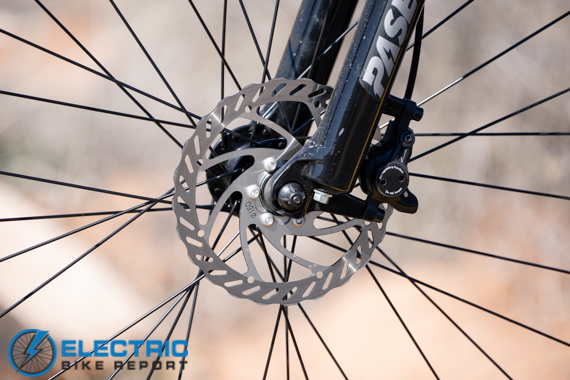
The Zoom hydraulic disk brakes and 180mm rotors.
PASELEC GS9 Review: Brakes and the Brake Test
The GS9 is equipped with Zoom hydraulic disc brakes with 180mm rotors — a reliable performer we’ve seen on numerous bikes we’ve tested. They have consistently been near or better than our average total stopping distance from all the bikes we put through our brake test.
I was able to come to an average stopping distance of 16’10” on the PASELEC GS9, which is one foot more than our current average. That result is quite good when you consider some important context about our braking test. The braking test is the one part of the EBR group effort that I least frequently conduct; that’s largely left up to my EBR colleague Sam Gross. I’ve comfortably got about 50 lbs more on my frame than they have on either of theirs. When we’ve tested bikes head-to-head in braking tests in the past it wasn’t uncommon for bikes to take another foot or two to stop my larger build.
So considering the GS9 was tasked with stopping a larger rider than we typically have to conduct our braking test, I’d say it performed quite well.
PASELEC GS9 Review: Ride Comfort, Handling and Cockpit
The most concise way I could sum up the handling of the PASELEC GS9 would be this: It’s mostly comfortable, yet a little bouncy.
The front fork does okay at absorbing the bumps of any uneven terrain. Since the geometry of the GS9 keeps you a little more forward on the handlebars, it’s nice that the fork can remove some of the impact that your arms would otherwise feel from the road.
The 40mm rear suspension does an okay job too, but it is the springiest part of the ride for sure. There’s a noticeable bounce as you hit bumps in the road, which is better than relying on your body alone to soak up the force, but adjusting to the pogo stick sensation took a little getting used to.
That’s somewhat to be expected from budget-priced componentry. The reason high-end mountain bikes cost as much as they do is the engineering that goes into them, and a huge chunk of that engineering is devoted to solving full-suspension performance, comfort and longevity. The HLT-100 SHOCK of the PASELEC GS9 is an off-the-shelf cheap offering that doesn’t match the performance of pricier components, so you’ll need to keep an eye on how it’s holding up with the understanding that you’ll have to replace it one day.
As far as shifting goes the L-Twoo A5 9-speed shifter got the job done. It shifted reliably in my time on the bike as long as I wasn’t asking it to shift under a heavy load, and it felt like an adequate gear range if you stick to the light-duty trails as I’ve mentioned.
The faux leather grips are ergonomically designed and they don’t twist at all – I ended up liking how they felt on my longer trips and appreciated that they didn’t twist around at all. The handlebar overall was a bit narrow for my broad shoulders and gave the bike some slightly twitchy handling — which for sticking to paved trails or lighter dirt I didn’t mind in the slightest.
The saddle is a bit firmer than you’d expect at first glance, but it isn’t a bad stock option. There will definitely be two camps on the spiderweb design of it though (you can find me in the camp against it).
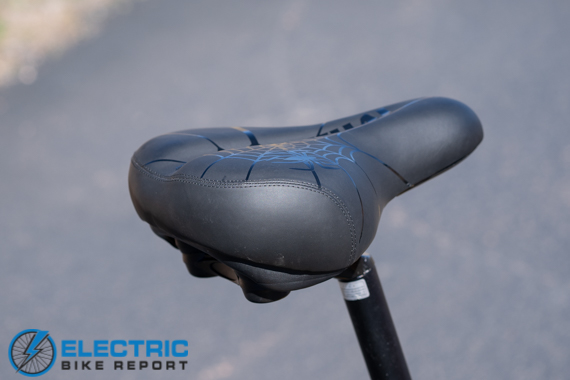
The included saddle is fairly plush and sports a spider web design.
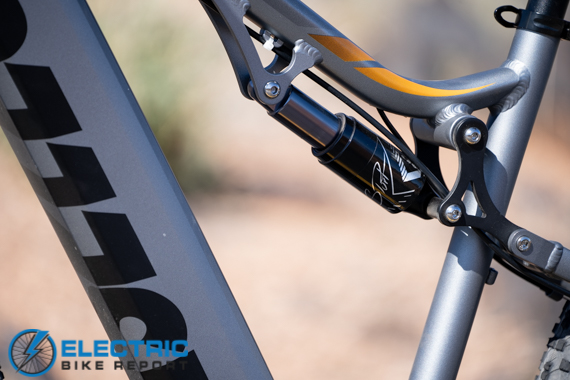
40mm of rear shock that does it’s job while being a smidge bouncy

The Zoom brakes have typically performed well across many bikes we’ve reviewed.
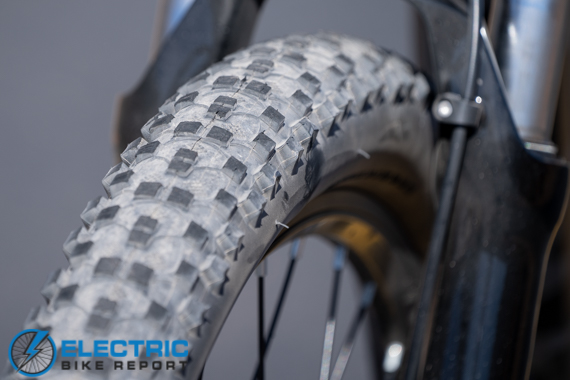
The 27.5” Kenda tires were surprisingly efficient rollers.
PASELEC GS9 Review: Summary / Where to Buy
I’ll conclude this PASELEC GS9 review with the same advice I gave at the start of it: setting your expectations about what this e-bike is will be the key to whether or not you end up enjoying it.
While it is a full-suspension e-bike with mountain bike styling, I’m not sure it’s fully equipped to handle the rigors of true eMTB-ing. Its handling and performance are not top-tier by any means, with my biggest question mark being on the longevity of the rear suspension, but for what you’re paying they certainly aren’t bad either (you don’t find Ferraris for Toyota Camry prices after all).
But can the GS9 be enjoyable on light-duty trails or paved paths? Absolutely.
One of the questions our audience asks us the most about across the comments section and social channels are about an e-bike’s battery life. The GS9 uses its battery very effectively for a bike that is capable of hitting class 3 speeds. A lot of that is thanks to a good 500W motor and 624Wh battery pairing, and having the bike rolling on some surprisingly efficient 27.5” Kenda tires.
When you toss in the effective brakes, good looks and an affordable price, you can find plenty here worth smiling about.
PASELEC sells the GS9 directly from their website to your front door from their website. You can check current pricing at the link here.
‘Happy Riding, make sure to let us know if you have any questions down in our comments section or if you think we left anything out in this review of the PASELEC GS9



Not bad $1350 for the first order. I don’t care for rear hubs off road.
Question: You mention a few time about the suspension under the seat. Is that hard to swap out?
It’s something best left to the pros.
…2nd follow up. I could definitely hear the motor in some of the video , but that might have been the wind, Is the motor recognizably loud when riding?
Not too bad on the motor, the suspension was more noisy.
Thank you loved the review. I am 62 years old and can crank on my own but don’t have the lasting power I used to so I need something to help me get up hill not a crazy down hiller anymore 🙂 I normally ride my gravel bike everywhere but I wanted an inexpensive option to rider fire roads and hilly area’s. This helped or if you know for a few more bucks a better suspension e bike ? for 800.00 dollars I don’t think you can beat it.